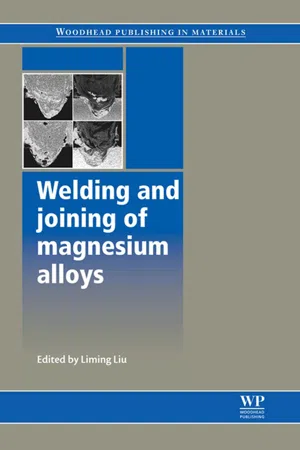1.1 Background
Magnesium, ranking eighth in the earth, is one of the most widely distributed elements and exists extensively in seawater and salt lakes. Magnesium alloy can be reused and recycled as an inexhaustible metal. As the lightest structural metal, it has many advantages, such as high specific strength and rigidity, high heat and electrical conductivity, which are close to those of aluminium (Al) alloys but much higher than engineering plastics, realizing the goal of lightening, energy saving and consumption reduction. Its characteristics, such as anti-knocking, antinoise high conductivity, electromagnetic shielding and nontoxicity, make it of great potential in mechanical field, marine scope and aviation application, etc.1,2 Due to the demands for energy saving and environment protection, magnesium is praised as a green engineering material and one of the most promising material categories in the twenty-first century. Relevant investigations and applications on magnesium alloys are in progress.
Because of the wide application of magnesium alloys, it is necessary to obtain a reliable joining process. Magnesium alloy components are joined by a variety of welding and joining methods including tungsten-arc inert gas (TIG), metal-arc inert gas (MAG), plasma h arc, electron beam, laser, friction and adhesive, besides friction stir explosion, stud, ultrasonic, spot welding and so on. For gas tungsten-arc filler welding processes of Mg alloys, many disadvantages appear, such as low welding speed, wide heat-affected zone (HAZ), high welding stress and significant evaporation; the tensile strength of the weld joint can reach 80–90% of the base metal by adjusting the welding parameters. This method can be applied in fixing casting defects and in lower demand fields.3 High-energy beam welding methods, including laser, plasma h arc and electron beam, have characteristics such as high energy density, low power input and rapid cooling rate, which result in deep penetration, small HAZ and fine microstructures. With optimized parameters, fine welds can be achieved with no crack, no pores and satisfactory appearance, most of which have obtained tensile strengths close to the base metals.4 Owing to beneficial interaction of the laser and arc, the combination of laser with TIG, called hybrid laser-TIG welding technique, can enhance the welding penetration, welding speed and quality of the weld, which makes this method fit for high-quality welding of Mg alloys.5 Friction stir welding is also being focused upon and developed in the past few years, especially applied to the field of light alloy welding. The friction stir weld of Mg alloy has a high tensile strength, resulting from the less quadratic phase separation in the cooling process with a lower stirring temperature.6 Finally, the other welding methods, such as adhesive, weld bonding, brazing, explosion and spot welding, have individual characters and advantages, which lead to their own application prospects of welding and joining of Mg alloys.
Although some progress was made in the last few years, several problems are still awaiting urgent solution in the welding process of Mg alloy, mainly present as increasing the fatigue strength of welded joint, developing efficient consumable electrode welding, dissimilar welding of Mg alloy to other metals and so on.
1.2 Characteristics of magnesium alloy welded joints under dynamic load
Comments about the Mg alloy weld dynamic load are receiving more attention with the application potential of Mg alloys in the fields of transportation. Actually, the dynamic performance of welding joint, including fatigue strength, impact ductility, bending strength, etc., is relatively low and is leading to the fact that Mg alloy is not a first choice in the fields of transportation. It is closely related to the welding process and to the properties of a base metal. Reports on the mechanism of fatigue crack of die cast of Mg alloys have been published, which revealed that cracks usually appeared in the surface of the material or along the pore in the sub-surface;7 some illustrated that cracks grow on the basis of a-Mg and then extend between a-Mg and the eutectic,8 and others said that the inhomogeneities of the secondary dendrite arm spacing and the grain sizes are the reasons affecting the fatigue properties of the Mg alloys.9 As for the Mg alloy weld, factors influencing the fatigue strength are as follows: excess weld metal, recess and various welding defects, such as cracks, incomplete fusion, pores and slag inclusions, resulting in stress concentration and certain residual stress. When the stress concentration, slag inclusion and the residual tensile stress meet, the fatigue strength of the welded joint is significantly weakened. Some researches on the fatigue strength of the Mg alloy welded joint have already been published.
Tsujikawa, Somekawa and Higashi have pointed out that the fatigue joint efficiencies of AZ31 joint and AZ61 joint by TIG or friction stir welding are about 80% and 60%, respectively.10 Fracture surfaces present brittle fatigue crack propagation, and moreover, the directions of crack propagation are influenced remarkably by the microstructures.
Kleinpeter, Rethmeier and Wohlfahrt have investigated the fatigue strength of the welded joints by metal inert gas (MIG), laser beam and electron beam.11 Depending on the profiles of the weld seams, the highest fatigue strength (55% of the base metal strength) can be reached with electron beam welding without filler metal as well as with laser beam welding with filler metal. For laser beam welding without filler metal and MIG welding, the fatigue strength decreases to 50%, whereas tests with removed weld reinforcements show fatigue strength of 75% of the base metal strength.
Asahina, Katoh and Tokisue researched friction-welded joints of AZ31 magnesium alloy and showed that fatigue limit of the welded joint is 93.1% of the base metal in rotary bending tester and 95.8% of the base metal in...
